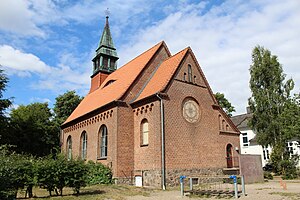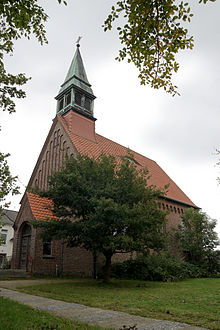Heilandskapelle (Flensburg)
|
Heilandskapelle from behind |
|
| Basic data | |
| Denomination | profane (formerly Evangelical Lutheran ) |
| place | Flensburg-Weiche , Germany |
| Building history | |
| architect | Otto Fielitz |
| construction time | 1910-1912 |
| Building description | |
| inauguration | April 21, 1912 |
| dedication | Built for God's honor in 1910 |
| Profanation | 1968 |
| Architectural style | historicism |
| Furnishing style | historicism |
| Construction type | chapel |
| 54 ° 45 '28.9 " N , 9 ° 24' 6.9" E | |

The Heilandskapelle in Flensburg 's Weiche district was originally built as a church building for the Evangelical Lutheran Church of Northern Germany in 1912. Today the chapel in Sylter Straße 7 is used by the neighboring Unesco School Weiche, the Heilandskapelle Weiche eV association and the district forum action group for the healthy district of Weiche . It is one of the district's cultural monuments . The chapel is not to be confused with the Christ Church in the Mürwik district .
history
Construction of the chapel
In 1901/1902, the town planning officer Otto Fielitz drew up the development plan for the site on the Nordschleswigsche Weiche. Since 1903 there were considerations to build a chapel. In 1904, the Flensburg-Weiche elementary and secondary school, today's Unesco school, was built at Bahnstraße 20 according to plans by the town planning officer Otto Fielitz. Since then, one of the rooms in the school has been used to hold church services for the parish of St. Nikolai until the Savior's Chapel was built . In 1907 the planning for the construction of the chapel began. Construction was delayed due to various problems. The need in Weiche was questioned within the parish of St. Nikolai. The tower of the Nikolaikirche also had to be repaired, which tied up funds. Furthermore, there were evidently access problems, so that the chapel could only be built between 1910 and 1912. The construction management was taken over by H. Höft. A small brick hall building with a chapel tower was created in a historicizing design. Bat dormers were inserted on both sides of the roof . A circular screen was inserted into the masonry on the outer choir wall. In this is the inscription "Built for God's honor 1910" (cf. Soli Deo Gloria ). The painter Käte Lassen created a monumental painting on the inside on the altar wall on the subject of “All come to me ...”, with the Savior in the center. There was space for 150 visitors on the gallery and in the chapel itself.
Use for church services
The Savior's Chapel was consecrated on April 21, 1912 and served as a place of worship for the next 56 years . After the consecration of the church, the new congregation initially still belonged to St. Nikolai. It was not until 1954 that the evangelical parish of Flensburg-Weiche became independent. The congregation was taken over by Pastor Hermann Hand, who served in Weiche until the 1970s.
The chapel initially had the address Bahnstrasse 20a. Later, when Sylter Strasse and Kirchenallee were established in 1955 , the chapel was given its current address. In 1958, Sylter Strasse was still undeveloped. There was only the chapel on the road. Today's row houses were built in 1960 .
Conversion of the chapel
After the Peace Church was built in 1966/67, the chapel was sold to the city in 1968. In 1972, the band was used as magazine of the mobile library Flensburg prepared. The altar , the pedestal of the altar and the pulpit were removed. At the same time, today's covered staircase was built in the entrance area of the chapel.
Since 1994, the Heilandskapelle has been used by the Unesco school as a music venue and meeting place. The Heilandskapelle Weiche eV association, which also uses it, promotes culture, encounters and urban development in Weiche. The district forum action group for the healthy district of Weiche , another user of the church, was probably also founded in the 1990s.
In 2012 the centenary of the Heilandskapelle was celebrated.
Individual evidence
- ^ A b Andreas Oeding, Broder Schwensen, Michael Sturm: Flexikon. 725 aha experiences from Flensburg! , Flensburg 2009, article: Heilandskapelle
- ↑ a b c d e f g h i j k Lutz Wilde: Monument topography Federal Republic of Germany, cultural monuments in Schleswig-Holstein. Volume 2, Flensburg, pp. 610-616
- ↑ a b c d e f Flensburg street names . Society for Flensburg City History, Flensburg 2005, ISBN 3-925856-50-1 , article: Kirchenallee
- ↑ Flensburger Tageblatt : Citizen Participation: Commitment to a “Healthy Neighborhood” , from: April 8, 2015; Retrieved on: April 8, 2016
- ↑ Flensburger Tageblatt : District forums: Weiche: Traffic is topic number 1 , from: December 28, 2015; Retrieved on: April 8, 2016
- ↑ Weiche where else. 100 years of Heilandskapelle Weiche: A “deserved” birthday child ( memento of the original from March 23, 2014 in the Internet Archive ) Info: The archive link was automatically inserted and not yet checked. Please check the original and archive link according to the instructions and then remove this notice. , Page 20, dated March 2012; Retrieved on: April 7, 2016

